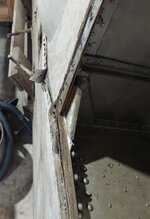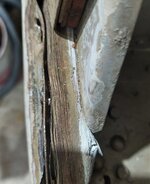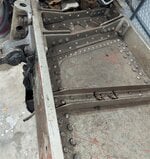I thought it had some connection to oil and cooling.
Navigation
Install the app
How to install the app on iOS
Follow along with the video below to see how to install our site as a web app on your home screen.
Note: This feature may not be available in some browsers.
More options
You are using an out of date browser. It may not display this or other websites correctly.
You should upgrade or use an alternative browser.
You should upgrade or use an alternative browser.
Kyusyu J7W1 "Shinden" CGI Project
- Thread starter Shinpachi
- Start date
Ad: This forum contains affiliate links to products on Amazon and eBay. More information in Terms and rules
More options
Who Replied?- Thread starter
- #202
Good point, Jim.I thought it had some connection to oil and cooling.
Significant difference between Fw190 and J7W1 is that the latter is a pusher type aircraft.
FAOW says -
"The lubricating oil cooler was designed with a cross-sectional area of 0.11m2 and a radiation tube length of 300mm to cool a large amount of oil with a maximum heat release of 3,000Kcal/min at an altitude of 4,000meters.
The oil cooler was installed in the rear fuselage (inside the cowling) of the engine and 45% of the engine exhaust was used to perform the Exhaust Induction Cooling by blowing it into the duct behind the cooler.
However, as a result of the test flight, it was confirmed that the oil temperature rose due to insufficient cooling effect. Therefore, a design change was planned to give some more dynamic pressure to the cooler but the war ended."
GrauGeist
Generalfeldmarschall zur Luftschiff Abteilung
Shinpachi-san, I have read that the J7W experienced severe shaft vibration during it's testing.
With your exceptionally detailed renderings, where could this vibration source have come from?
With your exceptionally detailed renderings, where could this vibration source have come from?
- Thread starter
- #205
I have heard such a shaft vibration occured on the J2M, which was caused by the lack of propeller rigidity, but not about the J7W1. I will check.Shinpachi-san, I have read that the J7W experienced severe shaft vibration during it's testing.
With your exceptionally detailed renderings, where could this vibration source have come from?
- Thread starter
- #206
Such a vibration like J2M's may have occured but J7W1's flight tests were carried out at the lower speed than 293.5km/h and no vibration was observed by the end of war.
Source: 震電 - Wikipedia
Source: 震電 - Wikipedia
Great work so far shinpachi!
I was a docent with NASM from '70s through the '90s, head docent for one term, set up the public tours at the Garber facility, and as one with aircraft building and maintenance background, was involved with a lot of the restoration. Also served on the acquisition and restoration advisory boards.
Bob Mikesh was the curator most associated with Japanese aircraft, and I'm sure many have read his well researched and accurate books. There were always curious issues with restorations, dealing with various country's demands, different design teams, and especially in WWII, changes in emerging technology and material availability. The latter especially influenced German and Japanese designs as the Allies did a great job of denying their foes critical elements and materials.
Here lies a tale, but I fear my memory is a bit sketchy. This involves either the J7W1 Shinden, but is more likely the Nakajima J9N1 Kikka, and deals with the late war metallurgy involved. Since they were both being developed in the same period, it may apply to both designs. Because of their technical design and rarity, both aircraft were high on the priority for restoration and conservation, however some surprises altered those plans.
The problem was that while the Japanese engineers sought the best alloys, they were denied crucial elements and had to make compromises. The aluminum alloy used for the wing spar was strong, but it turned out to be unstable. That was not an issue as it would not have a lengthy service life ... either combat loss or obsolescence would end their life before the deterioration was a factor. No one expected them to be around 50+ years later.
When the examined closely the wing skins were visibly bulging around the main spar. You could look at the machined spar surfaces and see it coming apart internally ... almost like dissimilar metal corrosion, but within the atomic structure. Mikesh submitted samples to metallurgists, and they said it couldn't be arrested, and that a complete new spar would have to be fabricated from modern alloys. The time, effort and cost pushed the restoration back where it remains to this day.
I believe Senior Curator Russ Lee now handles Japanese aircraft, and perhaps could clarify my aging memory and provide an update.
Bob Mikesh was the curator most associated with Japanese aircraft, and I'm sure many have read his well researched and accurate books. There were always curious issues with restorations, dealing with various country's demands, different design teams, and especially in WWII, changes in emerging technology and material availability. The latter especially influenced German and Japanese designs as the Allies did a great job of denying their foes critical elements and materials.
Here lies a tale, but I fear my memory is a bit sketchy. This involves either the J7W1 Shinden, but is more likely the Nakajima J9N1 Kikka, and deals with the late war metallurgy involved. Since they were both being developed in the same period, it may apply to both designs. Because of their technical design and rarity, both aircraft were high on the priority for restoration and conservation, however some surprises altered those plans.
The problem was that while the Japanese engineers sought the best alloys, they were denied crucial elements and had to make compromises. The aluminum alloy used for the wing spar was strong, but it turned out to be unstable. That was not an issue as it would not have a lengthy service life ... either combat loss or obsolescence would end their life before the deterioration was a factor. No one expected them to be around 50+ years later.
When the examined closely the wing skins were visibly bulging around the main spar. You could look at the machined spar surfaces and see it coming apart internally ... almost like dissimilar metal corrosion, but within the atomic structure. Mikesh submitted samples to metallurgists, and they said it couldn't be arrested, and that a complete new spar would have to be fabricated from modern alloys. The time, effort and cost pushed the restoration back where it remains to this day.
I believe Senior Curator Russ Lee now handles Japanese aircraft, and perhaps could clarify my aging memory and provide an update.
- Thread starter
- #209
Thanks for sharing the interesting and historically precious story, fannum. It is my honor to listen to you, sir.I was a docent with NASM from '70s through the '90s, head docent for one term, set up the public tours at the Garber facility, and as one with aircraft building and maintenance background, was involved with a lot of the restoration. Also served on the acquisition and restoration advisory boards.
Bob Mikesh was the curator most associated with Japanese aircraft, and I'm sure many have read his well researched and accurate books. There were always curious issues with restorations, dealing with various country's demands, different design teams, and especially in WWII, changes in emerging technology and material availability. The latter especially influenced German and Japanese designs as the Allies did a great job of denying their foes critical elements and materials.
Here lies a tale, but I fear my memory is a bit sketchy. This involves either the J7W1 Shinden, but is more likely the Nakajima J9N1 Kikka, and deals with the late war metallurgy involved. Since they were both being developed in the same period, it may apply to both designs. Because of their technical design and rarity, both aircraft were high on the priority for restoration and conservation, however some surprises altered those plans.
The problem was that while the Japanese engineers sought the best alloys, they were denied crucial elements and had to make compromises. The aluminum alloy used for the wing spar was strong, but it turned out to be unstable. That was not an issue as it would not have a lengthy service life ... either combat loss or obsolescence would end their life before the deterioration was a factor. No one expected them to be around 50+ years later.
When the examined closely the wing skins were visibly bulging around the main spar. You could look at the machined spar surfaces and see it coming apart internally ... almost like dissimilar metal corrosion, but within the atomic structure. Mikesh submitted samples to metallurgists, and they said it couldn't be arrested, and that a complete new spar would have to be fabricated from modern alloys. The time, effort and cost pushed the restoration back where it remains to this day.
I believe Senior Curator Russ Lee now handles Japanese aircraft, and perhaps could clarify my aging memory and provide an update.
To avoid historical misunderstanding for the security, such a characteristic as the early corrosion of Japanese aluminium alloy which was especially observed on the main spar, was caused not because to save material but to realize the rigidity by Sumitomo Metal Industries in 1936.
Thirty years later, my recollections are inexact, but my understanding was it was the unavailability of critical elements to properly alloy the aluminum. The plan was to duplicate replacement spar parts from modern and stable 7075 aluminum. Of course, this would require complete disassembly of the wing.
Apparently, the skin, ribs, etc. used different alloys.
Apparently, the skin, ribs, etc. used different alloys.
- Thread starter
- #211
Common recognition at Japanese side is that Sumitomo's contained too much zinc to use longer.
By the way, I am from Sumitomo
Camparison table

Source: 超々ジュラルミン本史(2)
By the way, I am from Sumitomo
Camparison table
Source: 超々ジュラルミン本史(2)
- Thread starter
- #212
This pic shows how the spar corroded well.
It doesn't look metal anymore but wood or paper.

Source:
View: https://twitter.com/A6M232/status/1039482048212135936
It doesn't look metal anymore but wood or paper.
Source:
View: https://twitter.com/A6M232/status/1039482048212135936
Tony Kambic
Airman 1st Class
These images are of the N1K1 Kyofu 'Rex' spar in the US Navy collection. This aircraft is now at American Aero Services in Florida awaiting restoration. The main wing spar exhibits the exact corrosion described above. I don't have a good image of the skin bulging as the skin was peeled back to show the deterioration. From what I read about aluminum corrosion, this appears to be a type named 'exfoliation corrosion'. The spar is very substantial.
I don't know the submitter of the corrosion commentary 'fannum' but have been a volunteer at NASM for about 20 years. I do know Curator Russ Lee.
I don't know the submitter of the corrosion commentary 'fannum' but have been a volunteer at NASM for about 20 years. I do know Curator Russ Lee.
Attachments
- Thread starter
- #215
Snautzer01
Marshal
- 46,292
- Mar 26, 2007
Very good.
I believe that "Rex" was one of the aircraft initially evaluated at PAX River, etc. and winding up on display outside for over 40 years at NAS Willow Grove. Well meaning group, but without funding to properly curate the collection or place it inside.
NASM curator Bob Mikesh worked with then SecNav Lehman to get them to Silver Hill and other responsible, better funded collections.
NASM curator Bob Mikesh worked with then SecNav Lehman to get them to Silver Hill and other responsible, better funded collections.
Great work so far shinpachi!
- Thread starter
- #219
GrauGeist
Generalfeldmarschall zur Luftschiff Abteilung
Shinpachi-san, your work is that of a master.
Users who are viewing this thread
Total: 1 (members: 0, guests: 1)



